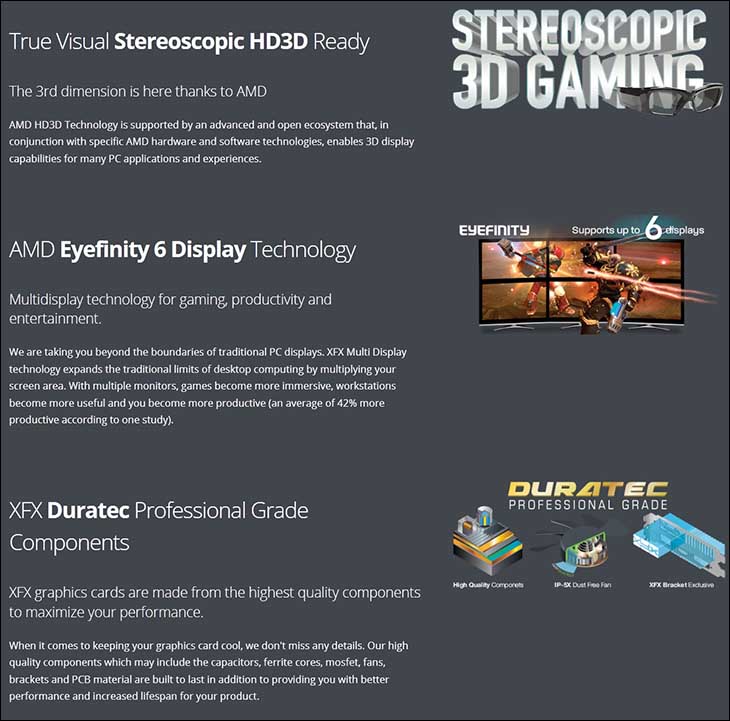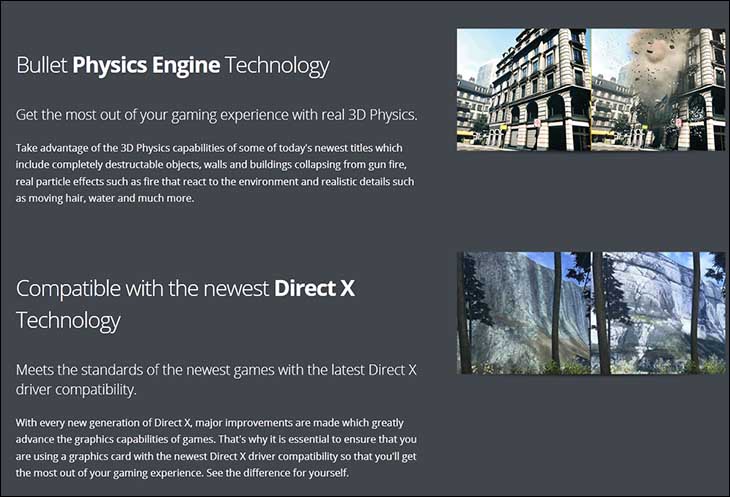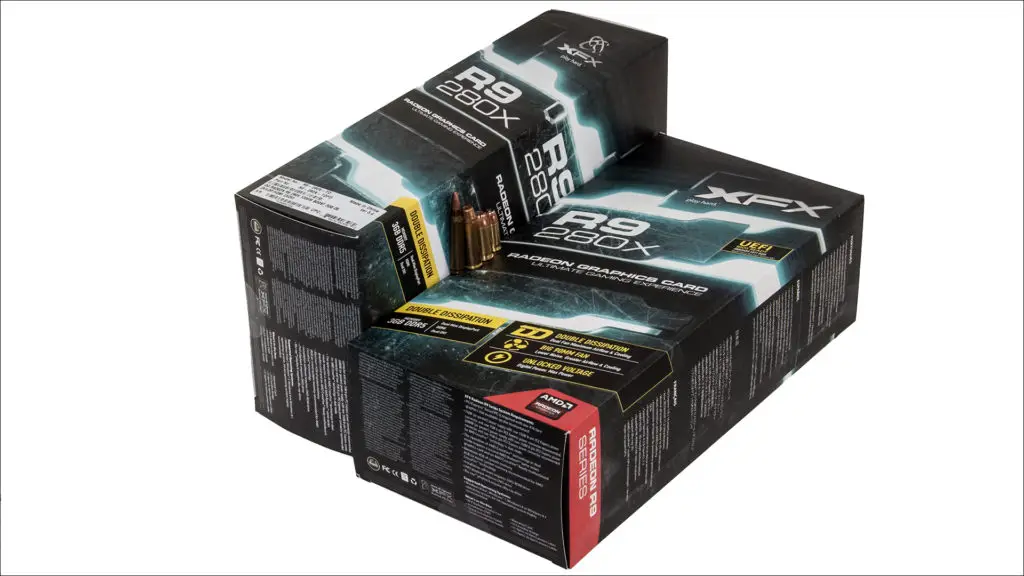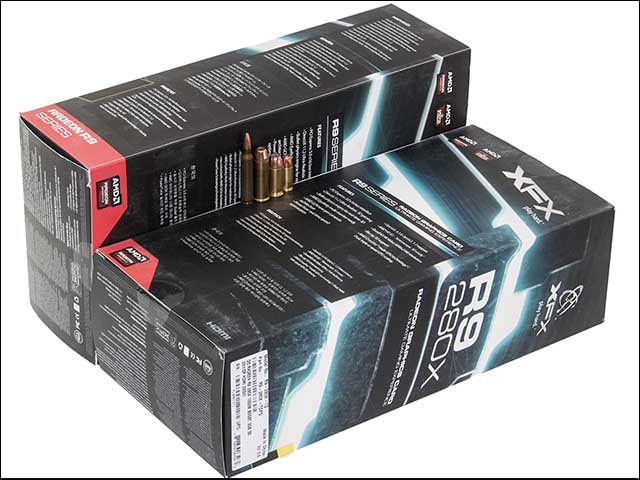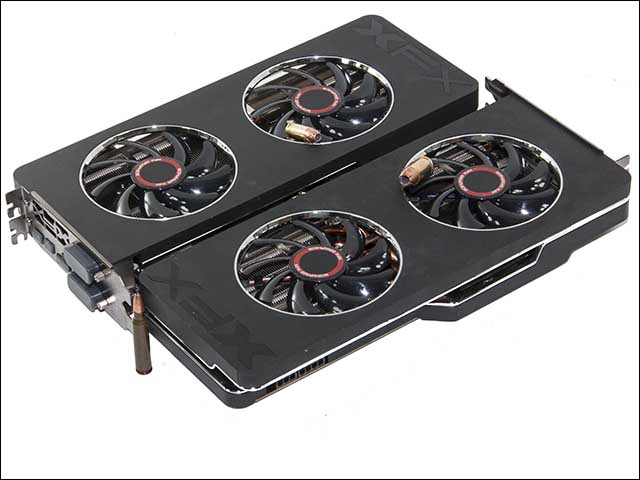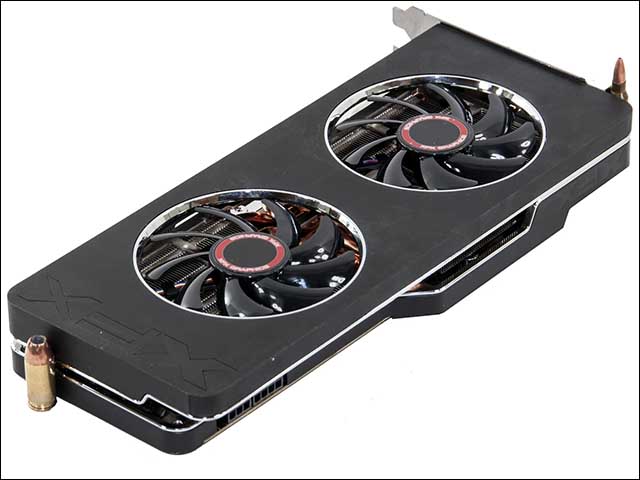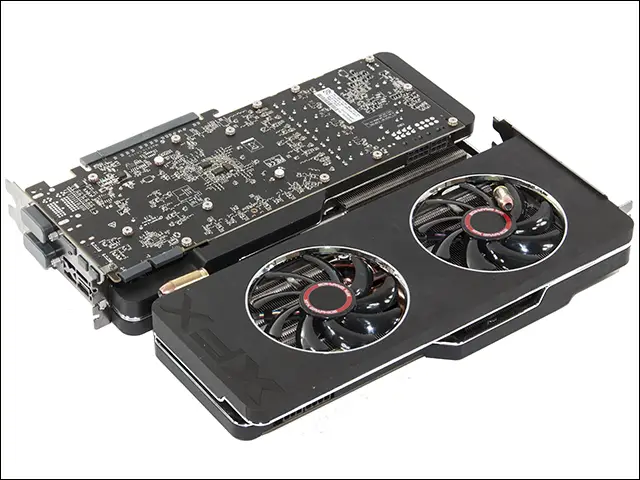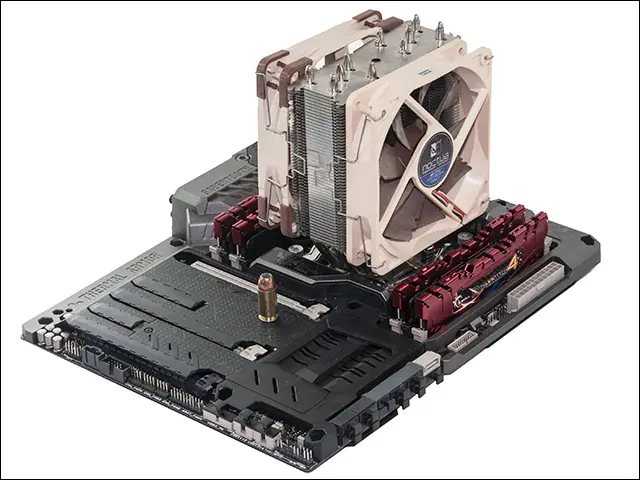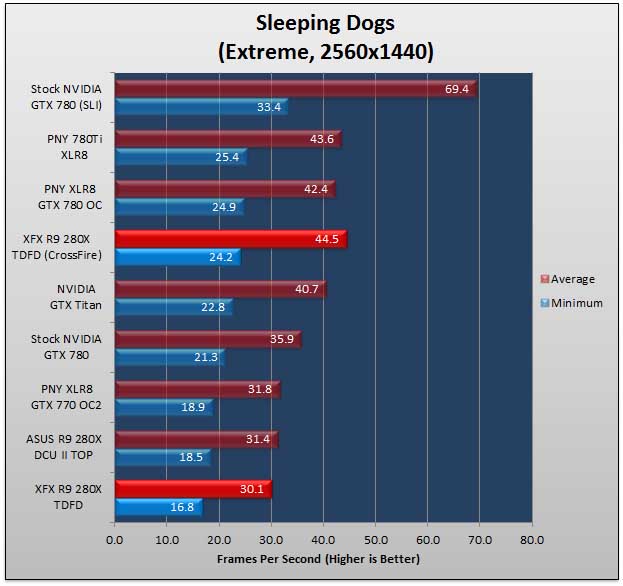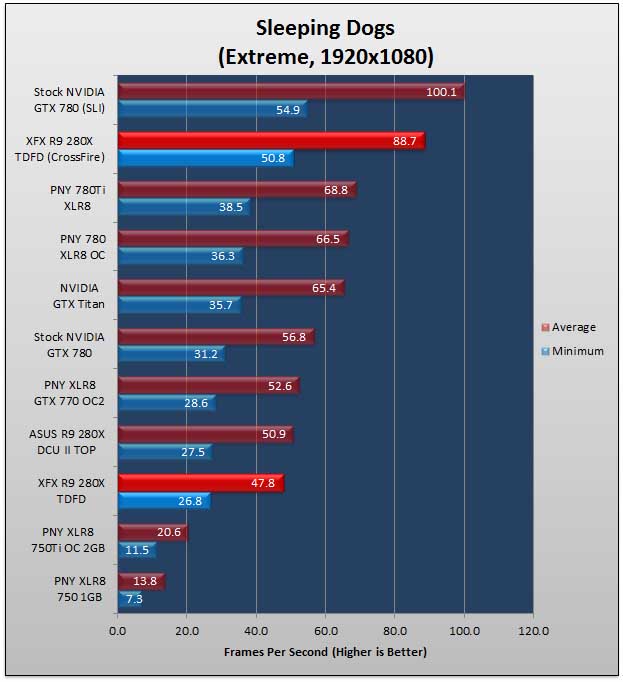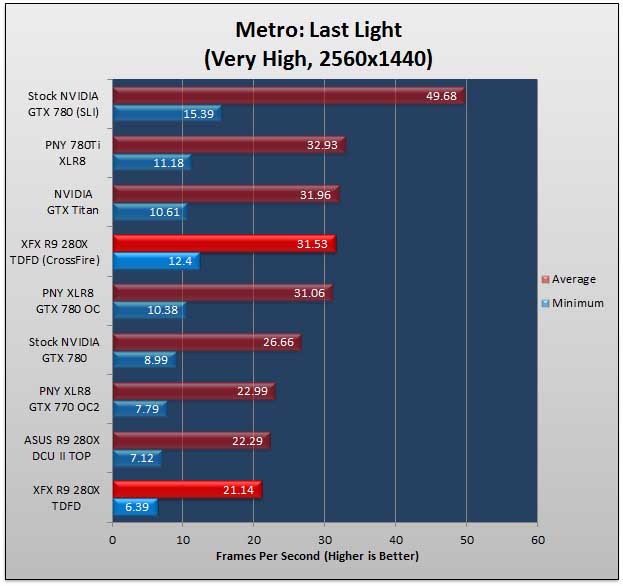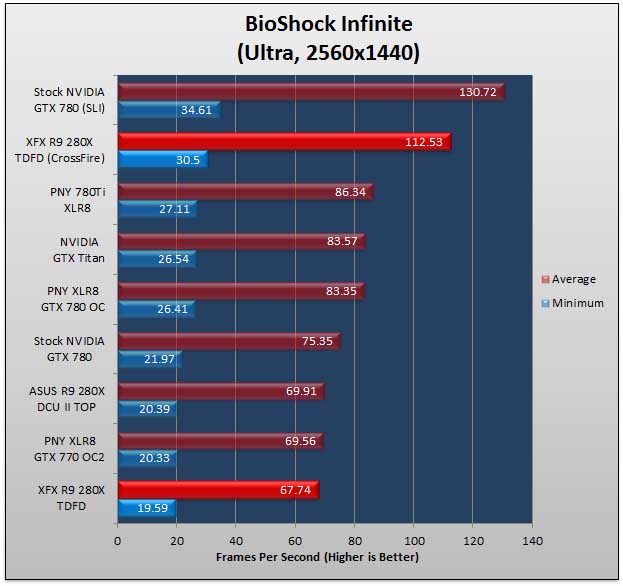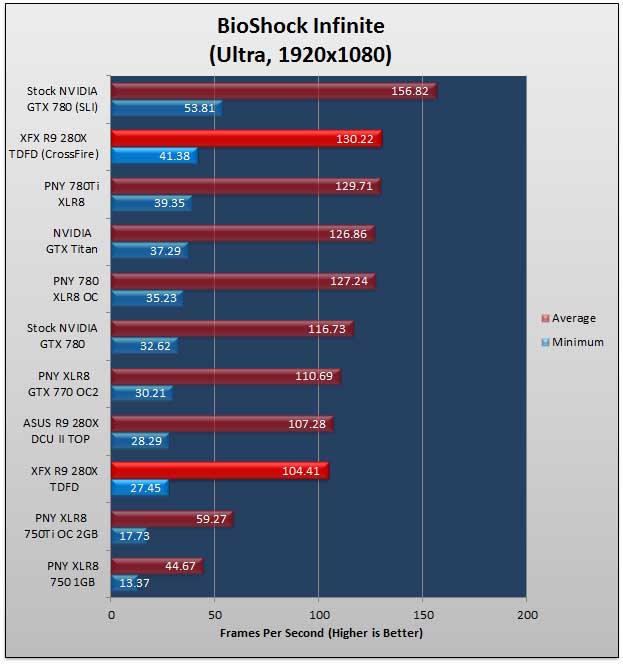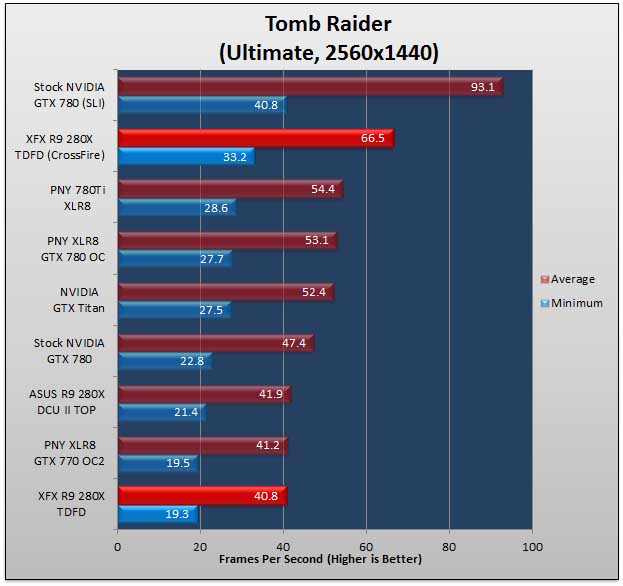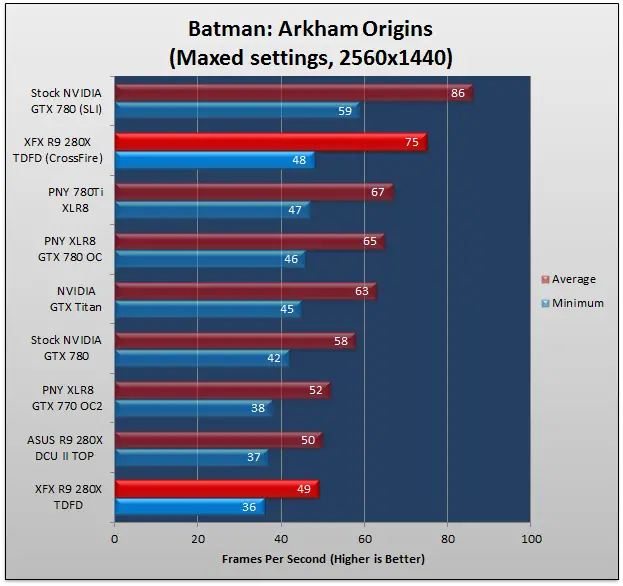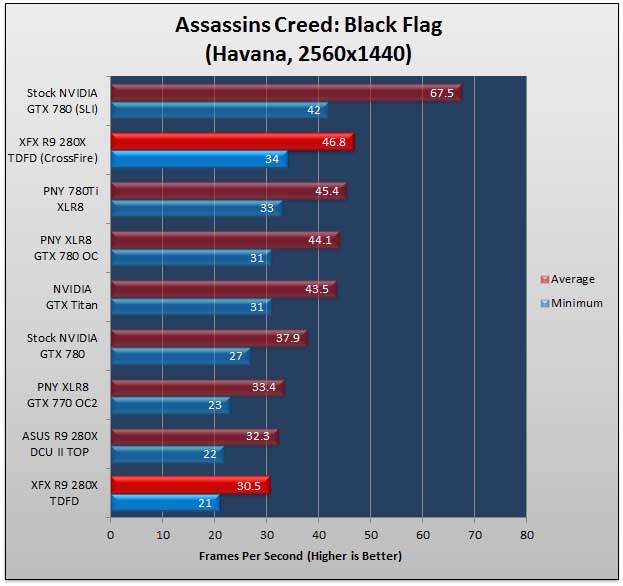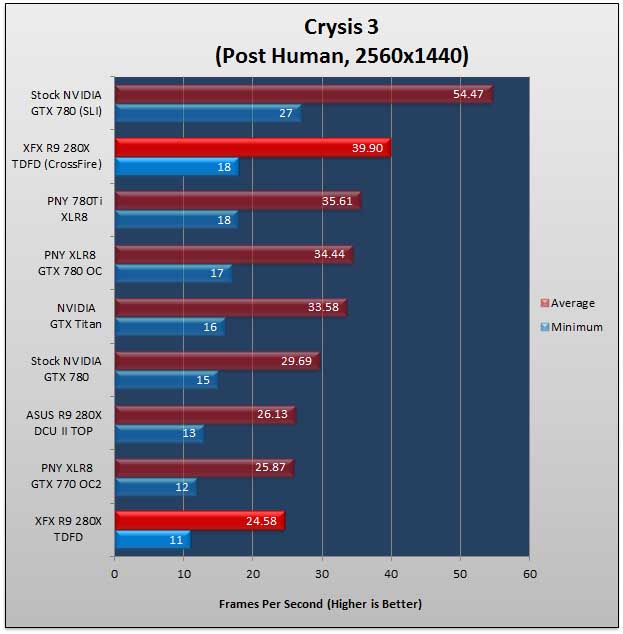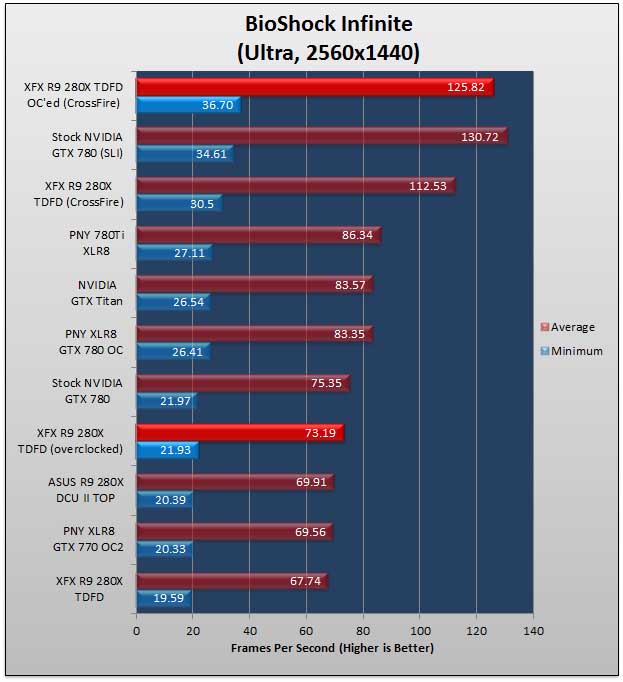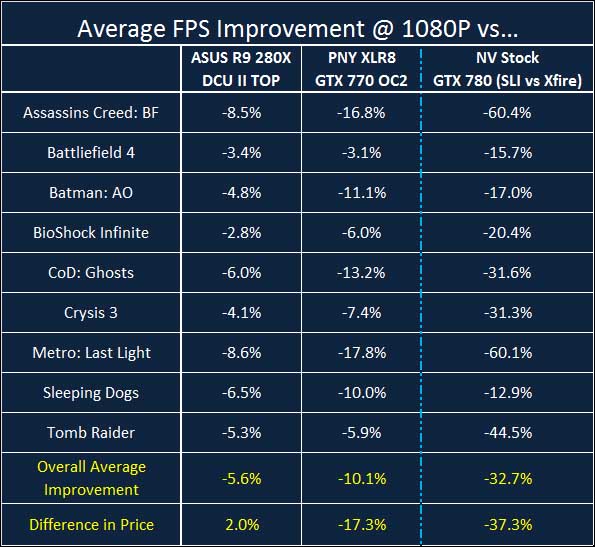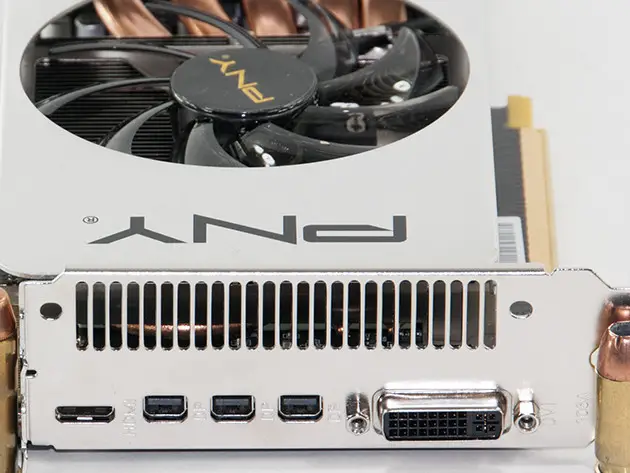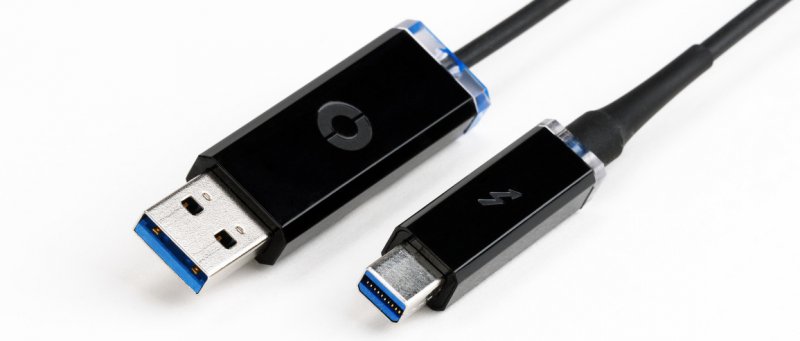XFX R9 280X TDFD 3GB – Introduction
Even with the latest rash of ultra-high end video cards, custom AMD R9 280X’ers are still a fan favorite for PC gaming enthusiasts. Put simply you get good performance and loads of overclocking headroom at a price that is damn reasonable. In fact the price is so reasonable that you can pick up two of these video cards for less than what a high end NVIDIA card will set you back.
The last time we looked at R9 280X cards we took a long hard look at the ASUS R9 280X TOP and walked away very impressed. This time we are focusing in on a new comer to our charts: XFX. XFX have a long and impressive history in the GPU marketplace and an even longer reputation for offering consumers unique solutions at fairly reasonable prices. Today we will put the TDFD version of the XFX R9 280X to the test to see what it is made of.
Colloquially referred to as their ‘Double D’ line of video cards the R9 TDFD comes equipped with a high performance stock cooling solution that makes this GPU easily the most aesthetically pleasing video card we have seen in a long while. Make no mistake these good looks are not skin deep and this custom cooling solution is sure to satisfy even the most demanding of overclocking enthusiast.
Curiously enough, XFX may have indeed bestowed their Double D 280X with an impressive custom heatsink and fan solution, but they have opted to forgo any factory overclocking. Instead the 280X’s Tahiti XTL core and the 3GB of DDR5 RAM have been left at stock levels. On the surface this certainly does not make much sense as this particular card will set you back $255 dollars, or $55 more than the typical stock R9 280X, and even $5 more than a pre-overclocked ASUS Top will. To fully explain these seemingly counter-intuitive pricing consumers need to understand that what these prices are really reflecting is a difference in GPU design philosophy.
Most GPU companies expect consumers to not overclock. Instead they offer pre-overclocked cards and expect consumers to consider that ‘good enough’. XFX takes a different approach to enthusiast video cards. They encourage you to never settle and expect you to find the sweet spot of your XFX card and not rely upon any factory crutches. Arguably this makes things a lot easier and cheaper for XFX as they don’t have to guarantee an overclock setting for every card they sell, but since you are encouraged to overclock – and as long as you don’t do any obvious physical damage – the lifetime warranty makes such an argument overly cynical.
We expect very big things from this particular 280X and fully expect it to easily justify its very reasonable asking price. This does however pose a very interesting ‘problem’ for enthusiasts – but one that is not new. Basically is it better to get one mid-grade video card or one ultra-high end video card? Usually that answer is fairly self-evident, but since NVIDIA recently released their 9 series, the last generation 7 series cards have also gotten much cheaper. So the real question now becomes, how much savings is too much? Put another way, is there a point where getting older high end cards becomes a better deal than getting two mid-grade ‘new’ cards? To this end we will not only be testing one of the XFX R9 280X cards, but two of them in Crossfire and comparing them to two NVIDIA 780s in SLI. Such a setup is obviously not a fair comparison and will have little bearing on our final conclusion of the XFX R9 280X, but with such a golden opportunity it would be unfair of us to not include all the information we could!
XFX R9 280X TDFD 3GB – Specifications and Features
XFX R9 280X TDFD 3GB – Closer Look
While not as eye catching nor exuding the same sense of elegance as the Asus R9 280X Top’s box, the XFX 280X (as we are going to call it for brevity’s sake) is still a very nice shipping container that puts the likes of PNY to shame.
Also on the positive side this box also resides in between PNY and ASUS in the form-factor department. Put concisely this box is larger than PNY’s options but not so large that you would mistake it for a mATX motherboard shipping container – like you would an ASUS Top. This will make finding room for the shipping container a lot easier and considering it comes with a 2 year warranty that can easily be extended to lifetime that is good news indeed.
The rest of the accessory list is a bit disappointing in comparison to the lifetime warranty, but only because a lifetime warranty is so impressive. In grand total you will get a driver disc with outdated drivers on it, a small installation pamphlet, a XFX advertising pamphlet on their other products, a 8-pin PCIe adapter cable, dual 6-pin adapter cable, and a Crossfire cable. Even more impressive is XFX includes dust caps for the PCIe x16 slot, and the I/O ports. Now that is what we call a complete accessory list.
As we have said in the past the $200-300 range is easily the most hotly contested corner of the video card market and every manufacture worth their salt has at least one card in this market niche – and usually multiple versions. However, this card was not originally a $255 card and it shows. Instead this card when first released was in the $350 range, but thanks to stiff competition it has been pushed – kicking and screaming – downwards in the marketplace. This not may have made XFX all that happy but it certainly is great news for customers.
This higher end mainstream orientation is why this card looks like a million bucks even when sitting on your computer table waiting to be installed. Even enthusiasts who have seen hundreds of video cards will do a double take when they first remove it from the shipping container for the first time. Just be careful you don’t drop it as it is not only drop dead gorgeous it is also rather robust and tips the scales in at nearly 1.5 kilograms. While this makes it heavy for a 280X no one would dare call it chunky looking. In fact anyone who compares it to a black Jaguar E-Type from the 60s would not be far off. Bluntly put this is one sexy card, that looks fast and will easily be the centerpiece of any custom gaming PC.
This unique look is all thanks to the massive amounts of black fascia XFX uses to hide their Double Dissipation design. The heart and soul of this Double Dissipation design is its dual 90mm fans and that is why they have been nicely highlighted with chrome borders surrounding them. This in combination with the flat black fascia and silver ‘racing stripe’ is certainly a winning one. However this combination is not just for looks.
Hidden underneath all that aggressive black fascia and fake chrome pin striping is two large aluminum heatsinks that are very impressive and should easily handle massive amounts of heat. To be more precise each 90mm fan cools its own large fin array with a total of six heatpipes sprouting from the main heatsink. Also noteworthy is that the base is copper and not aluminum like found on some mid-tier cards. More importantly XFX has not wasted any space nor made the card larger than it had to be. Instead this heatsink is just that big.
Unfortunately, one down side to this custom double D heatsink is that it’s oversized. As you can see it not only makes the 280X TDFD a long card but also a rather wide card. Specifically it is 11.61 inches long, 1.65inches (dual slot) high, and a whopping 5.63 inches wide. This last part is the kicker that may make it simply not fit in smaller cases as the usual video card is only approximately 4.4-inches wide. This is fairly par for the course with custom R9 280X’s and most cases will not mind this extra bit of room required but double check that your case will have no issues with its slightly oversized dimensions.
Before me move on there is one thing that we simply have to talk about. Put simply XFX needs to work on their assembly line as it looks like they used about half a tube of Thermal Interface Material! Quite literally the amount that squished out the sides and over the edge of the Tahiti XTL’s IHS was enough to do at least 3 coolers. They say a picture is worth a thousand words. Well the above photo is after we scraped off a ton of TIM. Ugh.
The power subsystem is also very impressive and consists of a 7+2 all digital design, with seven phases ensuring the Tahiti XTL core is fed smooth and stable power – even when overclocked. Opting for a dual phase VRM for the memory should also allow for easy overclocking of the RAM. It just is a shame that XFX does leave both parts at stock levels. Settings of 850MHz (1GHz boost) for the Tahiti XTL and 6,000 (effective) for the RAM is never, ever going to stress that massive heatsink, nor the very good power delivery subsystem.
It is unfortunate that XFX did not include a backplate for this custom PCB and while we doubt it will flex from the weight of the Double Dissipation it would have nicely finished the overall aesthetics of this sexy card and alleviated consumers concerns over bending cards. On the positive side the black PCB is very nice looking all its own. Also accessing both power connectors is relatively easy as neither are blocked by the heatsink or fascia. The same also holds true of the dual CrossFire connectors.
Turning the card around we can see that the rear IO panel has been directly copied over from XFX’s own older HD 7970 Double D card. That means you get two DVI ports, one HDMI port, and two mini DisplayPorts. Sadly by opting for two full sized DVI ports the amount of air that will exhaust out the back of your case will be limited – and instead most of the heat will circulate inside your case. On the positive side at least it doesn’t use a mini-HDMI port and instead makes use of the more standard ‘full size’ HDMI port.
XFX R9 280X TDFD 3GB – Testing Methodology
To fully test the abilities of a given video card, we have used a blend of in-game benchmarks and custom recorded real world game benchmarking. For custom game play we have used FRAPS to record the minimum and average frame rates and to do so for a set period of time. All tests were run a minimum of four times and the scores are the average of all four runs.
All games were patched to their latest version. The OS was a fresh clean install of Windows 7 with all latest hotfixes, patches and updates applied. All games were tested at the two of the most popular resolutions of 1080P (1920×1080) and then again at 1440P (2560×1440). This means each game’s tested was run a minimum of 8 times: 4 @ 1080P and 4 @1440P. Before testing Unigine’s Valley benchmark was run for 15 minutes to ‘warm up’ the video card. This was done to ensure that long term performance and not short term performance is being illustrated.
The games used for testing were:
Sleeping Dogs
Metro: Last Light
BioShock Infinite
Crysis 3
Batman: Arkham Origins
Tomb Raider
Battliefield 4
Assassins Creed: Black Flag
Call of Duty: Ghosts
For stress testing we used Unigine’s Valley benchmark.
For overclocking we used either the manufactures included software overclocking program or if necessary EVGA’s Precision X program.
Drivers:
GeForce 350.12
AMD Catalyst: 14.12 Omega
Processor: Intel i7 5930K
Memory: 16GB GSkill Ripjaws 4 DDR4-3000
Motherboard: Asus Sabertooth X99
Cooling: Noctua U12S
SSD: 1x Seagate 600 Pro 400GB, 2x Intel DC S3700 800GB SSDs.
Power Supply: Corsair AX860i
Monitor: Dell U2714H
OS: Windows 7 Ultimate x64 SP1
Synthetic Game Benchmarks (SGB)
In the Synthetic Gaming Benchmarks section we will show a number of benchmark comparisons of the ASUS R9 280x DCuII TOP and other comparable GPUs, using various benchmarks which come included with five popular modern PC games. This will illustrate how much performance this card has to offer. To ensure that long term performance is and not short term performance is illustrated 15 minutes of Unigine’s Valley benchmark was run to ‘warm up’ the video card. Only then were any tests run on the now warm video card.
Real World In-Game Benchmarks (RWGB)
In the Real Gaming Benchmarks section we will show a number of timed real world game play results using FRAPS and four popular modern PC games. This will illustrate how much performance the PNY GeForce GTX 770 XLR8 OC2 has to offer and do so in a way which cannot be unduly skewed by driver ‘optimizations’ which have been included for the sole purpose of improving benchmark results. While not as common as it once was such optimizing is still not unheard of by either AMD or NVIDIA. Once again Unigine’s Valley benchmark was run for 15 minutes to ‘warm up’ the video card prior to testing.
XFX R9 280X TDFD 3GB – Sleeping Dogs(SGB)
Sleeping Dogs is an open world action-adventure video game developed by United Front Games in conjunction with Square Enix London Studios and published by Square Enix, released on August 2012. Sleeping Dogs has a benchmark component to it that mimics game play and an average of four runs was taken.
The settings used in the testing below are the Extreme display settings and a resolution of 2560×1440 and 1920×1080. World density is set to extreme, Vsync disabled, high-res textures are enabled, and shadow resolution, shadow filtering, screen space ambient occlusion, and quality motion blur are all set to high.
At 1080P resolutions saving $50 will cost you about 5 frames per second compared to the NVIDIA $300 770 OC2. At 1440P it is under 2 frames per second. This obviously makes the 280X a much better value at higher resolutions. Conversely, when dealing with CrossFire configurations the lower the resolution the better value! This is because AMD’s CrossFire drivers for Sleeping Dogs are severely lacking. We would honestly rather spend the money on the fastest single video card than put up with the headaches CrossFire will throw your way when it comes to Sleeping Dogs. Hopefully, this is not the start of a (bad) trend for the XFX Double D 280X!
XFX R9 280X TDFD 3GB – Metro: Last Light(SGB)
Metro: Last Light is a DX11 first-person shooter video game developed by Ukrainian studio 4A Games and published by Deep Silver released in May 2013. The game is set in a post-apocalyptic world and features action-oriented gameplay. The game has a benchmark component to it that mimics game play. Scene D6 was used and an average of four runs was taken.
The settings used in the testing below are Very High for quality and a resolution of 2560×1440 and 1920×1080. DirectX 11 is used, texture filtering is set to AF 16X, motion blur is normal, SSA turned on and tessellation is set to high.
Metro Last Light is tough on video cards, and if you want results that are darn close to the more expensive NVIDIA offering your first priority will be to overclock this 280X – as the differences get even larger when comparing a 770 OC2 to the reference speed XFX 280X TDFD. Moving on to the CrossFire results you can see that Metro Last Light does not like Crossfire configurations and if this game is your favorite game we would not recommend spending the extra money on a second 280X. Either opt for a relatively more expensive single NVIDIA card, or opt for only one 280X. Doing otherwise is simply a waste of money.
XFX R9 280X TDFD 3GB – BioShock Infinite(SGB)
BioShock Infinite is a first-person shooter video game developed by Irrational Games, and published by 2K Games released in March 2013. The game has a benchmark component to it that mimics game play and an average of four runs was taken.
The settings used in the testing below are UltraDX11 (option 3) for quality and a resolution of 2560×1440 and 1920×1800.
BioShock Infinite is a title where if you want insanely high frame rates SLI or CrossFire is the only way to go. If you are interested in single card solutions overclocking will be paramount if you choose this 280X over a 770 OC2. If you are the type of person who does not want tinker with overclocking, you may want to consider saving $5, giving up a lifetime warranty and opting for the pre-overclocked ASUS 280X Top. On the other hand, if you plan on playing at 1080P resolutions the differences between a stock 280X and an overclocked 280X do not warrant the loss of lifetime warranty.
XFX R9 280X TDFD 3GB – Tomb Raider(SGB)
Tomb Raider is an action-adventure video game published by Square Enix and released in March 2013. The game has a benchmark component to it that mimics game play and an average of four runs was taken.
The settings used in the testing below are Ultimate default settings for quality, VSync disabled and a resolution of 2560×1440 and 1920×1080.
Tomb Raider is a game that usually favors AMD cards over NVIDIA and in single card configurations this certainly is true. However, AMD seems to need to work on their CrossFire drivers as the Crossfire results are not nearly as impressive. Put simply they are mess and this something that should never, ever be said about a AMD centric title that has been on the market as long as Tomb Raider has been.
XFX R9 280X TDFD 3GB – Batman Arkham Origins(SGB)
Batman: AO is an action-adventure video game published by Warner Bros and released in October 2013. The game has a benchmark component to it that mimics game play and an average of four runs was taken.
The settings used in the testing below are highest settings for quality, VSync disabled and a resolution of 2560×1440 and 1920×1080. Anti-Aliasing is set to TXAA (high). Motion blur, Distortion, Lens Flare, Light Shafts, and Reflections set to On. Geometry, Dynamic Shadows, Depth of Field, and Ambient Occlusion all set to DX11 Enhanced.
Batman AO is another AMD Gaming Evolved title but unlike the other AMD centric games it appears that both manufactures have heavily tweaked their drivers for this game. Because of this the XFX in single card configurations simply gets left in a GeForce 770’s dust. However, if you crossfire two of these 255 dollar cards the results are pretty darn nice. This is especially true at 1440P resolutions where the 280X can really flex its muscles.
XFX R9 280X TDFD 3GB – Battlefield 4(RWGB)
Battlefield 4 is first person shooter video game, published by EA Digital Illusions CE and released in October 2013. Unlike most, this games does not include an in-game benchmark. This makes it perfect for more real world gaming tests. To obtain repeatable results we have used FRAPs and recorded the first 90 seconds of the single player Tashgar level. An average of four runs was taken.
The settings used in the testing below are Ultra pre-set for quality, with VSync disabled and a resolution of 2560×1440 and 1920×1080.
Battlefield 4 is an AMD centric title and it comes as little surprise to see the XFX 280X post such darn good numbers. While yes a pair of 780s will net you even better performance CrossFire’ed 280X will give you silky smooth gameplay at 1080P and extremely good gameplay at 1440P. If you take the overclocking headroom into account the XFX 280X becomes an even better value, though if you don’t care about warranty the ASUS TOP 280X and its factory overclock could be a more optimal solution.
XFX R9 280X TDFD 3GB – Assassins Creed:Black Flag (RWGB)
Assassins Creed: BF is an historical action-adventure video game, published by published by Ubisoft and released in October 2013. Like Battlefield 4 this games does not include an in-game benchmark. This makes it perfect for more real world gaming testing. To obtain repeatable results we have used FRAPs and recorded a custom run through Havana’s marketplace. An average of four runs was taken.
The settings used in the testing below are highest settings for quality, VSync disabled and a resolution of 2560×1440 and 1920×1080. Environment quality was set to very high, Anti-Aliasing was set to TXAA 4X, Ambient Occlusion set to HBAO+ (high), Shadow Quality set to ‘soft shadow’, Motion Blur and Volumetric Blur both set to On. Texture Quality, Reflection Quality, and God Rays all set to High.
With Assassins Creed Black Flag you can expect a 50-65% boost in performance by using two XFX 280X’s in Crossfire over one XFX 280X. This certainly is not bad and the results are very decent. Then again if you can afford the more expensive 780 SLI configuration you may want to think long and hard about paying the extra money – as the performance boost is significant. In either case if you do opt for the XFX 280X you really, really will want to overclock the hell out of it. Otherwise you will have wasted $55. If you are not interested in overclocking saving $5 and opting for an Asus TOP 280X is also a very enticing proposition. You will get better out of the box performance, and lower noise, but you will have to give up the lifetime warranty.
XFX R9 280X TDFD 3GB – Call of Duty:Ghosts (RWGB)
Call of Duty: Ghosts is a first person shooter video game, published by Activision and released in October 2013. Since it does not include an in-game benchmark, it perfect for more real world gaming testing. To obtain repeatable results we have used FRAPs and recorded 90 seconds of the single player ‘Ghost Stories’ level, starting as soon as we resume control of Logan back on Earth. An average of four runs was taken.
The settings used in the testing below are highest settings for quality, VSync disabled and a resolution of 2560×1440 and 1920×1080. Image Quality, Textures Resolution, Normal Map Resolution, and Specular Map Resolution set to Extra. Screen Space Ambient Occlusion and Antistrophic Filtering set to High, Terrain Detail set to ON, and Anti-Aliasing was set to TXAA 4X. With Shadows, Distortion, Motion Blue and Depth of Field set to Yes.
As with some other games in our stable, the Crossfire results for Call of Duty Ghosts is a mess. By the same token in single configurations the results of this XFX card are pretty darn good. Put simply the results are more than playable at even 1440P resolutions. This goes double considering the amount of overclocking headroom this card offers – but is not represented in our benchmarks!
XFX R9 280X TDFD 3GB – Crysis 3 (RWGB)
Crysis 3 is a first person shooter video game, published by Electronic Arts and released in February 2013. While older than some of the others it is one of the most visually stunning games released to date and puts a lot of demands on the GPU. This makes it perfect for more real world gaming testing. To obtain repeatable results we have used FRAPs and recorded 90 seconds of the single player ‘Post Human’ level, starting as soon as soon as prophet is handed a Hammer II pistol by Psycho. An average of four runs was taken.
The settings used in the testing below are highest settings for quality, VSync disabled and a resolution of 2560×1440 and 1920×1080. Texture Quality, Game Effects, Objects, Particles, Post Processing, Shadows, Shading, Water, and System Specs all set to Very High. Motion Blur was set to High and Lens Flare was set to On. Anti-Aliasing was set to MSAA 8X and Antistrophic Filtering was set to 16x.
Crysis 3 is hard on single video card solutions and is very demanding on memory bandwidth. This is why we were so happy to see Crossfire actually provide a very nice boost to the 280X. As you can see it certainly is not doubling of performance, but at this point simply being able to consistently pull ahead of single video cards costing more than these 280X is a ‘win’ in our books.
XFX R9 280X TDFD 3GB – Temp, Noise and Power
For all temperature testing the cards were used in an open test bed environment. Ambient temperature was kept at a constant 20°C (+/- 0.5°C) and if the ambient room temperatures rose above 21°C or dropped below 19°C at any time, all benchmarking was stopped until proper temperatures could normalized.
For Idle tests, we let the system idle at the Windows 7 desktop for 25 minutes and recorded the peak temperature.
For Load tests, we ran Unigine’s Valley benchmark for 20 minutes.
If nothing else these results prove that the Tahiti XTL is a hot running core. By the same token the Double D cooler certainly allows this card’s temperatures to be very reasonable and to be within grasping distance of NVIDIA cards. This to us means consumers can’t base their purchase decision based on core temperatures. It literally is a non-issue during normal gaming scenarios and instead consumers can make their decision based on performance – just as it should be.
Sound Level Test Results
While everyone “hears” noise differently there is one easy way to remove all subjectivness and easily compare different fans: use a sound level meter. This way you can easily compare the various fans noise envelopes without us coloring the results and see what fans fit within your personal comfort level. Of course, we will endeavor to try and explain the various results – which are taken at a 15 inch distance from the GPU’s fan(s) – to help you gain an even better understanding of how loud a cooler’s stock fan is, but even if you discount our personal opinions, the fact remains numbers don’t lie.
For Idle tests, we let the system idle at the Windows 7 desktop for 25 minutes and recorded the peak dB.
For Load tests, we ran Unigine’s Valley benchmark for 20 minutes and recorded the peak dB.
To be honest we are a bit disappointed by these results. This card is slightly louder than an Asus 280X TOP and considering it is cooling a much cooler running core – as the Tahiti XTL is not overclocked – this is not all that impressive. By the same token this card is not that loud and the noise it creates is easy to ignore. Is this difference worth $45 more to you? Only you can answer that question.
System Power Consumption
To obtain accurate results we have connected the system to a Power Angle power meter that has in turn been attached to a 1500watt UPS. This ensures only 120volt power is supplied to the PSU and removes an variances that could potential crop up because of brownouts and power spikes.
In order to stress the video card we have once again used Unigine’s Valley benchmark and ran it for 20 minutes to determine peak system power consumption. For idle results we have let the system idle at the Windows 7 desktop for 25 minutes and recorded the peak idle power consumption.
Yes, this card does use more power than NVIDIA cards do. Yes this means more heat will be produced; however with such a massive custom heatsink backstopped by two large fans the extra heat does not really matter. As for more power, if you compare this cards power consumption to that of say a reference GeForce GTC 780, the extra 12 watts of power means it will take thousand of hours of non-stop gaming to make up the difference in price between them. In other words it’s a non-issue…unless you need an excuse to spend more money for the obviously more powerful card.
XFX R9 280X TDFD 3GB – Overclocking
To discover our XFX R9 280X TDFD sample’s overclocking abilities we used EVGA’s Precision X software and began raising power and thermal thresholds to the maximum allowed and then increased the voltage also to the maximum permitted. Then using Unigine’s Valley benchmark we began stability testing.
As expected this card is a phenomenal overclocker. Simply put, the combination of this core, this ram and this cooler allows for massive overclocking headroom. You will find so much headroom that at 1440P resolution you can expect this $255 card to act more like a reference NVIDIA GeForce GTX 780. At 1080P you can expect it to perform similarly to a heavily overclocked GeForce GTX 770. Either way that is a rather large and free boost in performance.
While one of our two cards was slightly better at the end of the day we were able to reach a clock of 1,170MHz. To put that in perspective that is an 17% boost in performance and a whopping 170Mhz increase over a reference AMD R9 280x’s levels. More importantly it was a level that this card could run at constantly and not only momentarily hit and then go back down to a more ‘reasonable’ speed.
On the memory side of the equation we were able to boost the memory to an effective 7090Mhz, which is a 18.2 percent improvement over the card’s default overclock of 6000Mhz – and massive 1090MHz boost over its ‘stock’ 6000Mhz setting. Most of this manual overclocking improvement is of course due to the impressive Double D custom cooling solution but it really was the combination of that excellent cooler and the excellent phase VRM that allowed us to reach such lofty heights.
XFX R9 280X TDFD 3GB – Performance Summary and TL;DR
In an effort to make sorting through all the results as easy as possible we have combined the results all of all the game results into an easy to digest summary format. By comparing the XFX R9 280x TDFD to similar products in all the games you will be able to easily find the game(s) you are interested in, see the improvement and decide if the XFX R9 280x TDFD is the worth the investment.
To be completely fair this card is the oddity in that it really was never meant to be used as a stock 280X. As such these are the two absolute worst case scenarios for this video card. With that taken care of the XFX 280X is still a very, very good value card that can hold its own against more expensive GeForce GTX 770s.
Yes it may technically be slower – in stock vs stock configuration- than the $5 cheaper ASUS option, but as stated that is not entirely true. In more realistic scenarios they are damn close to each other, but even in ‘worst case’ scenarios the XFX does come close to the ASUS TOP. Considering that five dollars gets you a lifetime warranty that is five dollars well spent – even if you leave this card at stock settings.
Unfortunately, the crossfire results are all over the place. This is not the XFXs fault and rather is a direct result of AMD not taking Crossfire as serious as NVIDIA takes SLI. To be blunt Crossfire drivers are a mess. When it works it is excellent, when it doesn’t you are left with a very expensive single 280X. That is not the type of endorsement consumers are looking for – and it is all AMDs fault.
Score Card and Summary
Packaging & Accessories:9 out of 10
Class leading accessory bundle, decent packaging and a lifetime warranty. What more could you ask for?!
Functionality & Aesthetics: 18 out of 20
While yes it is oversized, the XFX R9 280X is as good a performer as it is good looking. When you mix in the massive overclocking headroom there is really not much to nitpick about this design.
Build Quality & Warranty: 18 out of 20
This card looks gorgeous, performs very well and is built like a custom hot rod. When you mix in a lifetime warranty there is not much to complain about on this front…besides the half tube of TIM they use on the heatsink.
Performance: 22 out of 30
A stock R9 280X is a very decent video card but one that is easily outclassed by cheaper factory overclocked cards. Thankfully the Double Dissipation custom heatsink, and robust power subsystem makes evening the odds a breeze. As such we consider the XFX 280X’s performance damn decent – but only if you put the necessary effort into overclocking them!
Value: 17 out of 20
It is unfortunate that XFX has not given these cards an factory overclock – as there is tons of headroom. When you consider ASUS charges five dollars less for arguably even better overclocking headroom and includes a factory overclock ‘starting’ point, the XFX TDFD does become a touch harder to justify from a performance standpoint. Thankfully, XFX’s lifetime warranty blows ASUS’ 3 years out of the water and makes spending more for technically less performance a lot, lot easier.
Final Score: 84 out of 100
We can honestly say that we really, really like this card. Not only does it easily justify its asking price it will make your entire custom system look better. We truly wish other companies would take note on how to make a custom heatsink and fan solution that looks bloody gorgeous -as such options are sorely lacking in the market right now. Good value, good overclocking performance, great looks – this card really is the full package when it comes to ‘value’ cards!
XFX R9 280X TDFD 3GB – Closing Statement
Let us end by saying we really like this card. It may not be the fastest, quietest, or even most power efficient card we have ever seen but it still is a great card in its own right and easily one of the better deals you can find in the market today. If you are looking for a card that really is the epitome of value, elegance, and sheer sex appeal than this is the card you want. Period. End of Sentence. The fact that you also get a lifetime warranty is simply icing on the cake.
The secret to this cards success is its custom Double Dissipation heatsink. Yes XFX was rather juvenile in their naming of this custom heatsink design but the fact remains it is one impressive piece of engineering. This in conjunction with an excellent power delivery system makes cooling the Tahiti XTL core as simple as you could ever want. In fact, leaving one of these thoroughbreds at stock settings would be like using your brand new Ferrari to go grocery shopping. Sure you can do it, but it would be foolish. Honestly if you are not interested in overclocking, we recommend saving a few dollars and opting for a factory overclocked model like the ASUS 280X Top.
With all that being said we would feel remiss if we did not mention the variable CrossFire results. In fact, the above recommendation is predicated on the assumption that you are only looking for one video card. Two cards is an entirely different ball game. Put simply AMD’s Crossfire drivers are severely lacking in comparison to their NVIDIA counterparts. Yes that is going to bring the wrath of fanbois down upon our heads but it is the truth. Expect there to be times that using two cards will simply not work, expect other times where the performance improvement is nowhere close to justifying the added expense, and expect other issues to randomly crop up on a case by case basis. If you are the type who likes plug and play simplicity we strongly recommend skipping SLI and Crossfire solutions and instead getting the fastest single card solution you can afford. If you absolutely need two cards, you will want to spend the extra money and opt for NVIDIA solution. SLI certainly is not perfect but at this time SLI is simply more user-friendly solution.
With all that being said when things work the way they should a pair of these very reasonably powerhouses will net you phenomenal results. So if you are the type not afraid to tinker with .ini files, and spend some effort getting everything to work properly then these two cards will offer you a fantastic value. This goes double if you take the time to first overclock the two XFX R9 280X TDFD’s!









